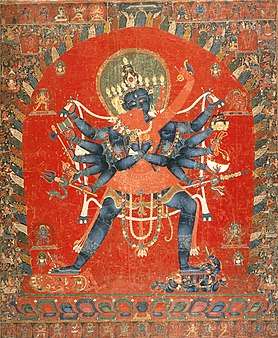Cakrasaṃvara Tantra
The Cakrasaṃvara Tantra (Sanskrit: चक्रसंवर तन्त्र), Khorlo Déchok or Khorlo Demchok (Tibetan: འཁོར་ལོ་བདེ་མཆོག, Wylie: 'khor lo bde mchog ) is considered to be of the mother class of the Anuttarayoga Tantra in Vajrayana Buddhism.[1] It is also called the Discourse of Sri Heruka (sriherukabhidhana) and the Samvara Light (Laghusamvara). David B. Gray dates this tantra to the late eight or early ninth century.[2]

| Part of a series on |
| Vajrayana Buddhism |
|---|
 |
|
Traditions Historical traditions:
New branches:
|
|
History |
|
Pursuit |
|
Practices
Fourfold division: Twofold division: Thought forms and visualisation: Yoga:
|
|
Festivals |
|
Tantric texts |
|
Ordination and transmission |
The Cakrasamvara Tantra is mostly dedicated to describing rituals and meditations which produce either mundane siddhis (accomplishment) such as flight and the supramundane siddhi of awakening. These are achieved through deity yoga (visualizing oneself as the deity) and the use of mantras.[2]
Deity and mandala
The central deity of the mandala, Saṃvara, is a form of Heruka, one of the principal yidam or meditational deities of the Sarma schools of Tibetan Buddhism.[3] Saṃvara is typically depicted with a blue-coloured body, four faces, and twelve arms, and embracing his consort, the wisdom dakini Vajravārāhī in Yab-Yum. Other forms of the deity are also known with varying numbers of limbs.
According to the Buddhist Tantric scholar Abhayakaragupta, the deity's mandala is described thus:
In the Samvara mandala there is a variegated lotus atop Mount Sumeru within an adamantine tent (vajrapañjara). Placed on it is a double vajra, which sits as the base of a court in the middle of which is the Blessed Lord. He stands in the archer (alidha) stance on Bhairava and Kalaratri who lie on a solar disk atop the pericarp of the lotus. He is black and has four faces which are, beginning with the front [and continuing around counter-clockwise], black, green, red, and yellow, each of which has three eyes. He has a tiger skin and has twelve arms. Two arms holding a vajra and a vajra-bell embrace Vajravarahi. Two of his hands hold up over his back a white elephant hide dripping with blood. His other [right hands hold] a damaru drum, an axe, a flaying knife (kartri), and a trident. His remaining left [hands hold] a khatvanga staff marked with a vajra, a skull-bowl filled with blood, a vajra noose, and the head of Brahma. A garland of fifty moist human heads hangs about his neck. He has the six insignia, and a sacred thread made of human sinew. He has a row of five skulls above his forehead, and a crest of black dreadlocks topped by a left-oriented crescent moon and a double vajra. He is endowed with a fierce meditative state (vikrtadhyana) and bears his fangs. He brings together in one the nine dramatic sentiments (navarasa).[4]
Saṃvara and Vajravārāhī are not to be thought of as two different entities, as an ordinary husband and wife are two different people; in reality, their divine embrace is a metaphor for the union of great bliss and emptiness, which are one and the same essence.
In Western meditation texts his name is often translated to mean "Highest Bliss". Meditation on Cakrasaṃvara is an advanced practice transmitted by one's lama, and binds the mind of the meditator to enlightenment itself.
Influence of Saivism
The Samvara texts adopted the pitha list from the Saiva text Tantrasadbhava, introducing a copying error where a deity was mistaken for a place.[5]
Gallery
 Chakrasamvara, 18th-century painting, Rubin Museum of Art
Chakrasamvara, 18th-century painting, Rubin Museum of Art Chakrasamvara mandala, Nepalese painting from 1490
Chakrasamvara mandala, Nepalese painting from 1490
See also
- Guhyasamāja tantra
Notes
- Buswell 2013.
- Gray, David B. The Cakrasamvara Tantra: Its History, Interpretation, and Practice in India and Tibet, Santa Clara University, Religion Compass 1/6 (2007): 695–710, http://vajrayana.faithweb.com/chakrasamvara-tantra%20its%20history.pdf
- Gray & Yarnell 2007.
- Gray, David (2007), The Cakrasamvara Tantra (The Discourse of Sri Heruka): Śrīherukābhidhāna: A Study and Annotated Translation (Treasury of the Buddhist Sciences), pp. 44-45.
- Huber, Toni (2008). The holy land reborn : pilgrimage & the Tibetan reinvention of Buddhist India. Chicago: University of Chicago Press. pp. 94–95. ISBN 978-0-226-35648-8.
References
- Buswell, Robert Jr; Lopez, Donald S. Jr., eds. (2013). Princeton Dictionary of Buddhism. Princeton, NJ: Princeton University Press. pp. 162–163. ISBN 9780691157863.CS1 maint: ref=harv (link)
- Gray, David B.; Yarnell, Thomas F. (2007). The Cakrasamvara Tantra: the discourse of Śrī Heruka (Śrīherukābhidhāna). American Institute of Buddhist Studies at Columbia University. ISBN 978-0-9753734-6-0.CS1 maint: ref=harv (link)
Further reading
- Chetsang Rinpoche; Clark, Robert (tr.) (2009). The Practice Of Mahamudra. Snow Lion. ISBN 978-1559393232.
- Dharmabhadra, Dṅul-hu; Gonsalez, David (tr.) (2010). Source of Supreme Bliss: Heruka Chakrasamvara Five Deity Practice and Commentary. Snow Lion Publications. ISBN 9781559393652.
- Gray, David B. (2003). "The Chakrasamvara Tantra: The Text and Its Traditions". In Huntington, John C.; Bangdel, Dina (eds.). The Circle of Bliss: Buddhist Meditational Art. Serindia Publications. ISBN 9781932476019.
- Yeshe, Losang; Gonsalez, David (tr.). The Ecstatic Dance of Chakrasamvara: Heruka Body Mandala Practice and Commentary. Dechen Ling Press. ISBN 978-0-615-78851-7.
External links
- Sacred Visions: Early Paintings from Central Tibet, an exhibition catalog from The Metropolitan Museum of Art (fully available online as PDF), which contains material on Cakrasaṃvara Tantra (see index)
- Berzin, Alexander (February 2012). "Introduction to the Chakrasamvara System of Anuttarayoga Tantra". studybuddhism.com. Study Buddhism. Retrieved 2016-06-03.CS1 maint: ref=harv (link)
